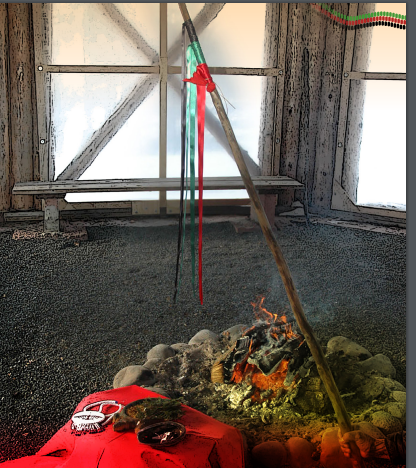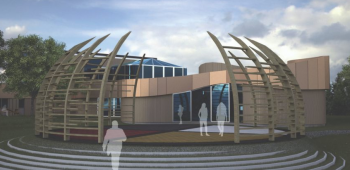Image Caption
Summary
Local Journalism Initiative Reporter
Windspeaker.com
After more than 150 years of colonial oppression and damage to the people of Anishinabek legendary Chief Shingwauk, Mary Wabano-McKay thinks his dream of an educational partnership between First Nations and settler people may finally become a reality.
An $18 million investment by the federal and Ontario governments and Algoma University is being used to create a new centre to be called Mukqua Waakaa’igan, meaning Bear’s Den.
It’s a national centre for teaching, learning and cross-cultural studies, “drawing from multi-disciplines through an Indigenous lens, as well as including global perspectives,” explained the Algoma vice-president in an interview from Sault Ste. Marie, home of the university’s main campus.
Algoma, situated on the grounds of the former Shingwauk Residential School, is committed to creating the centre to fulfill the original dream of the chief. He wanted to “create a teaching wigwam that spoke to cross-cultural education and the sharing of worldviews” between Indigenous and settler peoples, Wabano-McKay said.
Shingwauk was an Anishinaabe chief who fought for the rights of his people in the 1840s and 50s, and negotiated the Robinson Treaties of 1850.
The residential school was in operation from 1878 to 1970, and the former school building is now part of the university.
The name Mukqua Waakaa’igan was given through ceremony. In Anishinaabemowin, Mukqua, the bear, is a carrier of medicine, and as such, a healer; Waakaa’igan refers to its lodge or den. Algoma University will ensure that the significance of this name will be reflected throughout the project’s functional design, according to a recent news release.
It’s hoped that Mukqua Waakaa’igan will serve as a centre of cultural excellence; a place where people of all cultures will be welcomed from around the world to share and learn from and with each other as part of the university’s commitment to creating a safe, welcoming and inclusive place for cross-cultural understanding, teaching, learning and research, the release states.
“Mukqua Waakaa’igan will showcase the decades of ‘truth telling’ work led by the Children of Shingwauk Alumni Association and the Shingwauk Residential Schools Centre,” said Algoma University President and Vice-Chancellor Asima Vezina.
“As part of our commitments to the Calls to Action (of the Truth & Reconciliation Commission), Mukqua Waakaa’igan will provide a safe and culturally appropriate space to house and care for the archives from the residential schools’ history, the Aboriginal Healing Foundation Collection and other important historical documents,” Vezina added.

Algoma started planning the new project, “through ceremony and the work of spirit,” just over two years ago, finally securing government money— $7.1 million from Canada and $5.9 million from the province—last May, said Wabano-McKay. The university will contribute the balance of $4.7 million.
Blending an academic approach with Indigenous ways of knowing will be a key challenge in the operation of the centre.
Wabano-McKay expects the facility will bring people together to “think beyond this knowledge we've all been immersed in through formal education…. to deconstruct and decolonize our ways of knowing and thinking about our relationships and our place with humanity in the world.”
Although shovels aren’t yet in the ground yet, the vice-president says subject areas for discussion are already being planned. Faculty already working in cross-cultural learning are bringing forward ideas, many that relate to global issues relating to the environment, water and food scarcity. Mental health and addictions, issues of high importance to First Nations, is another area for examination.
Smoke Architecture of Hamilton, Ont., along with Moriyama & Teshima Architects of Toronto have been selected as designers of the new building. Smoke Architecture is an Indigenous-owned architecture firm that focuses on Indigenous projects. The entire design and construction process will be done “through a decolonized lens,” from procurement of materials to the selection of construction firms, Wabano-McKay said.
One challenge is the search for unmarked burials on the site that is the preferred location for the new centre. Searches conducted under the direction of the group representing survivors and their families took place this fall, with results expected sometime in the new year, she said.
Construction was originally slated to start next spring, but may be delayed depending on the findings of the ground-penetrating radar scans. University staff will “take their lead” from the survivors group, and “no work will commence” without their approval, Wabano-McKay explained.
Elders with the Children of Shingwauk Alumni Association are “very happy” to see planning for the centre continue, “all the while respecting the important site search work currently underway,” said search coordinator Jay Jones.
Planning the new centre has been exciting for Algoma. Hopes are that Muqwa Waakaa’igan will lead to an expansion of programs, faculty and also enrollment.
Still, “at the same time as we are looking forward, we certainly have to pause to look back and see what we have inherited as this legacy across the country,” Wabano-McKay explained.
“The whole country has to come to terms with the dark and painful history of the legacy of Indian residential schools.”
Local Journalism Initiative Reporters are supported by a financial contribution made by the Government of Canada.

